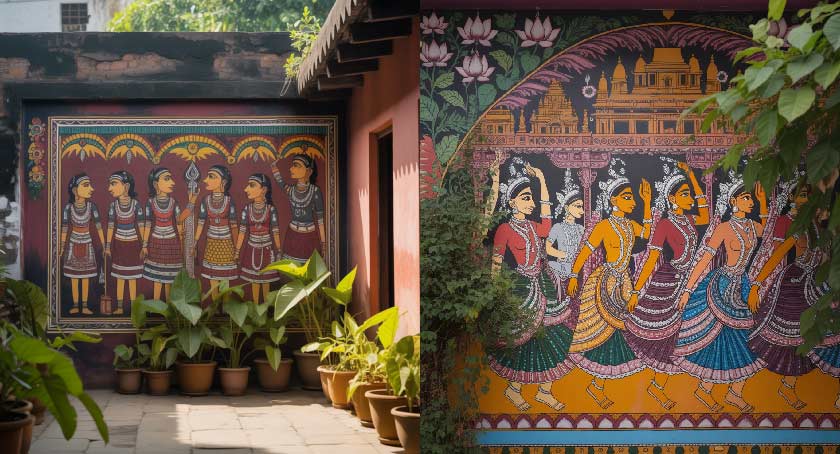Odia Home Art: Wall Murals and Frescoes Through the Ages
Odisha, a culturally rich state on India’s eastern coast, is celebrated for its grand temples, classical dance forms, vibrant festivals, and profound spiritual heritage. While colossal art forms like those at the Sun Temple in Konark or the Jagannath Temple in Puri have drawn attention from all over the world, wall murals and paintings found in old Odia homes are another tradition that is just as captivating. Often overlooked in grand historical narratives, these artworks represent a profoundly personal and community-centered expression that has endured for generations.
Historical and Cultural Context
The tradition of mural painting in Odia homes dates back centuries and finds roots during the reigns of regional dynasties such as the Eastern Ganga, Bhoi, and later the Maratha rulers. While the temples of Odisha stood as public expressions of religious devotion and state-sponsored art, the walls of homes served as intimate canvases that reflected ordinary people’s daily lives, beliefs, and cultural practices. These murals were more than just ornamental; they were spiritual, ceremonial, and deeply symbolic.
In rural Odisha, especially, homes became sacred spaces during festivals and life-cycle events. Artists adorned the walls with paintings that not only beautified the surroundings but also conveyed religious narratives, social customs, and an appreciation for the environment. The influence of Odisha’s famed Pattachitra scroll painting is evident in the stylistic elements of these murals, blending classical aesthetics with folk creativity.
Techniques and Materials Used
The creation of these wall murals and frescoes was grounded in sustainable practices. Traditional artists—often women of the household or local artisans—used naturally sourced materials and derived pigments from minerals and organic substances. White came from lime, red from red oxide, black from soot or charcoal, yellow from turmeric or yellow ochre, and green from crushed leaves. These natural dyes were eco-friendly and imbued the paintings with earthy vibrancy.
The surface of the walls, typically made from mud, lime, or cow dung plaster, was prepared carefully before painting. In the case of frescoes, artists applied pigments directly onto freshly laid lime plaster. As the plaster dried, the pigments fused with the surface, creating a lasting bond that ensured durability. This technique, known for its permanence, parallels other ancient cultures, including Roman and Renaissance European fresco traditions.
Themes and Motifs
The subjects of these murals varied by region, festival, and family tradition, but typically revolved around the following themes:
- Mythological Narratives: Many murals depicted scenes from sacred epics such as the Ramayana, Mahabharata, and Puranas. Images of Lord Jagannath, Krishna’s playful exploits in Vrindavan, Vishnu’s avatars, and Durga slaying Mahishasura were popular. These mythological visuals transformed household walls into sacred spaces, turning daily life into an extension of devotion.
- Folk Deities and Tribal Beliefs: In regions with strong tribal influence, such as Koraput and Keonjhar, the murals often depicted local deities like Dharni Penu (the Earth Goddess), Gram Devata (village gods), and ancestral spirits. Artists typically painted these on outer walls to ward off evil and attract good fortune as protective emblems.
- Nature and Daily Life: Murals frequently celebrated agrarian life and the close relationship between people and nature. Depictions of farming, domestic chores, animals, birds, and trees vividly portray rural life. Scenes of women drawing water, men herding cattle, children playing, and festivities like Raja Parba (celebrating womanhood and fertility) or Nuakhai (new harvest festival) told stories of a deeply interconnected society.
- Geometric and Floral Patterns: In addition to narrative illustrations, many murals featured decorative patterns, including lotus flowers, vines, circular mandalas, and conch shells. These motifs held symbolic meanings—fertility, abundance, spiritual purity, and the cyclical nature of life.
Regional Variations
Different parts of Odisha developed their mural styles:
- Western Odisha (Sambalpur, Kalahandi): Known for Sanjha paintings, made with rice paste, these artworks were typically created by women during specific festivals. The designs were ritualistic and symbolic, often linked with goddess worship.
- Southern Odisha (Koraput, Rayagada): Tribal communities favored earthy tones and minimalist forms, with murals that represented ancestral spirits, animals, and forest elements. These artworks connected the spiritual realm with everyday existence.
- Coastal Odisha (Puri, Cuttack): Strongly influenced by the Pattachitra style, murals here were detailed and colorful. Themes often revolved around the Jagannath cult and other Vaishnavite traditions, rendered in bold lines and vibrant hues.
Social and Ritual Significance
Wall painting was not a solitary artistic endeavor but a communal, familial, and ritualistic act. During major life events, such as marriages, childbirth, and festivals, women would repaint sections of the walls, signifying a renewal of blessings and spiritual protection. People often performed this process with devotional songs and prayers, enhancing the sacred atmosphere.
Families passed down the art form through generations as a living tradition. Daughters learned by observing their mothers and aunts, ensuring continuity of style and meaning. In many communities, especially in western Odisha, villagers collectively painted entire walls during festivals, strengthening community bonds and celebrating shared heritage.
Final Thoughts
The wall murals and frescoes of ancient Odia homes are silent witnesses to a vibrant, living culture that intertwined devotion, art, nature, and daily life in brushstrokes of profound beauty. Though many of these masterpieces have faded with time, their legacy endures in the motifs that still adorn village festivals, Pattachitra scrolls, and the hearts of those who value Odisha’s artistic heritage.
To truly experience the depth of this tradition, one must travel beyond museums—into the homes, hearts, and heritage of the Odia people. Whether preserved on mud walls or reimagined on modern ones, this art form continues to speak a timeless language of beauty and belonging.


